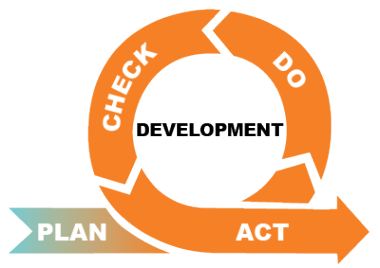Phase 2 - Development

In Phase 2, EPP and district partners focus on ways to jointly support educator candidates through all facets of educator preparation and into early-career induction. Partners use key data to explore and adjust expectations, requirements, and activities to align clinical experiences with district curriculum, instruction, and assessment as well as other areas identified for improvement. As partners begin to align coursework and clinical experiences with district priorities, they will develop and implement several short- and long-term action plans to address partnership needs.
The essential aspects of the development phase may require a significant amount of the partners’ focus and time. Partners may revisit this phase to refocus and redefine its goals as initial partnership goals and milestones are met.
Suggested Timeframe: 6-18 Months
Essential Aspects of Developing and Implementing Effective Partnerships
- Jointly select and train clinical mentors; strategically place educator candidates.
- Establish common language and frameworks to support strategies for improving clinical experiences for educator candidates.
- Implement a process for frequent, ongoing communication and feedback.
- Develop and implement several mutually beneficial, needs-driven, short-term and long-term action plans or joint projects.
- What shifts might need to happen at the EPP level to support the partnership’s vision and goals? At the district level?
- What forecasting can the district provide regarding its staffing needs?
- Are there recent policy changes or changes in trends that may impact the supply of teachers in specific areas?
- What mechanisms are available to improve the educator pipeline (e.g., placing candidates for clinical experiences in schools with forecasted needs)?
- How will the partnership ensure clinical mentors are prepared to support educator candidates in meeting expectations for program completion during the clinical experience?
- How will partners ensure that the partnership work positively impacts the clinical experience for teacher candidates?
- How will partners work together and hold each other accountable to ensure that the partnership action plans are implemented?
- What outcomes will partners use to measure the success of partnership efforts?
Process Considerations
- Determine Clinical Practice Improvement Strategies – Partners mutually agree on expectations for effective clinical experiences. Partners collaboratively develop and document ways to select and train clinical mentors and strategically place educator candidates.
- Establish Communication Procedures – Partners create a communications plan that includes regular meeting times; processes for frequent, ongoing communications; and ways to obtain stakeholder feedback. Partners should establish and document how they will share data, information, and outcomes throughout the partnership.
- Intentionally Share and Utilize Organizational Data – Partners continue to share, analyze, and utilize data to monitor action plan progress against intended outcomes, making adjustments as necessary.
- Ongoing Assessment of Partnership Needs – Using the results of the SWOT analysis as a starting point, partners should continually assess partnership needs to drive adjustments to current action plans or develop new goals.
- Maximize Partner Human Capital – Partners add ‘ad hoc’ members (e.g., more HR staff when addressing clinical mentoring, more building-level administrators when addressing clinical placements, etc.) to increase capacity as needed.
- Protect Collaborative Time – Partners ensure sufficient time is set aside for engagement in partnership work with minimum distractions from other responsibilities.
- Innovate Use of Fiscal Resources – Partners consider creative and innovative ways to maximize the fiscal resources available to support this work. Partners consider ways to leverage existing or create new funding streams to support partnership initiatives. Strategies that might open doors for more innovative use of fiscal resources include seeking out joint grant opportunities, sharing staff positions, and providing joint professional learning activities.
- Develop and Implement Action Plans – Action plans are implemented because of the need for a specific change. Managing a partnership through such change initiatives requires focus and intentionality to successfully bring about desired change. Partners are encouraged to use a model such as the one described here to manage complex change resulting from action plan implementation.
- Monitor and Evaluate – Strategies for monitoring and evaluating progress, as well as plans for continuous improvement and partnership sustainment, are important considerations at the onset of action plan development and throughout implementation.